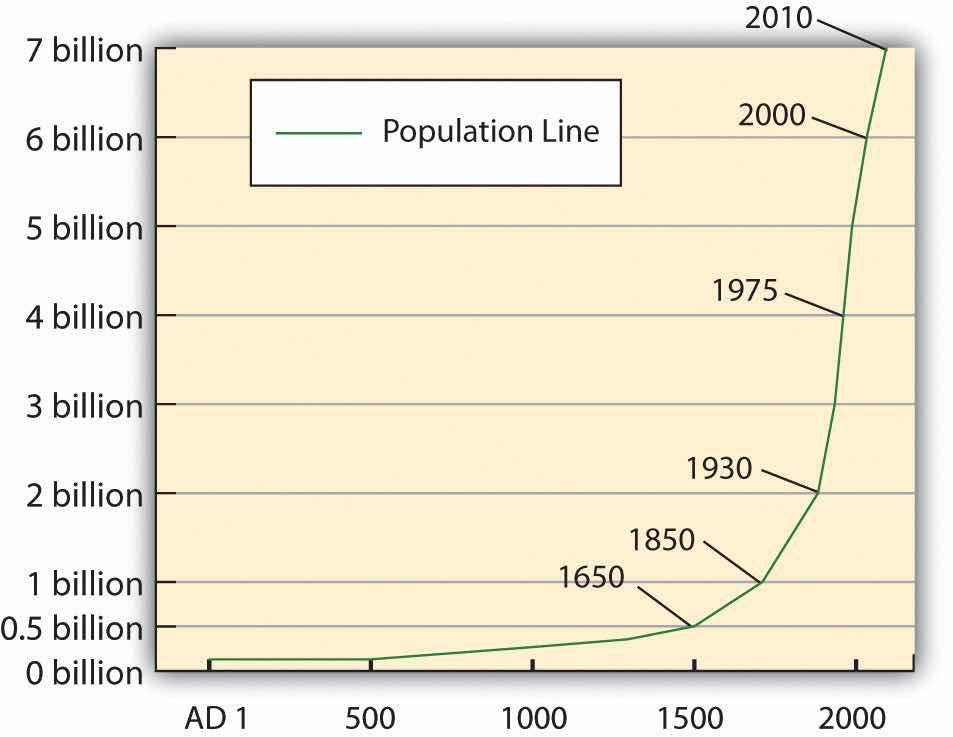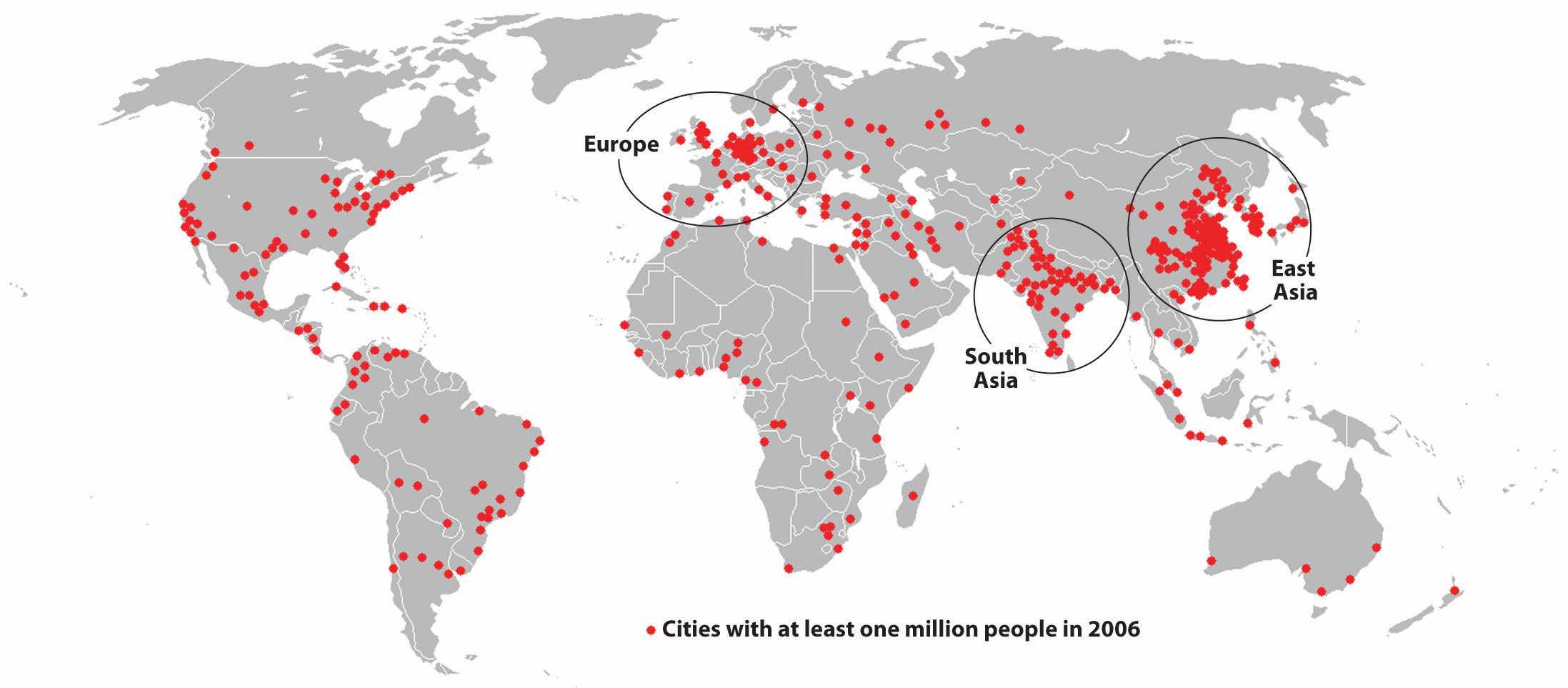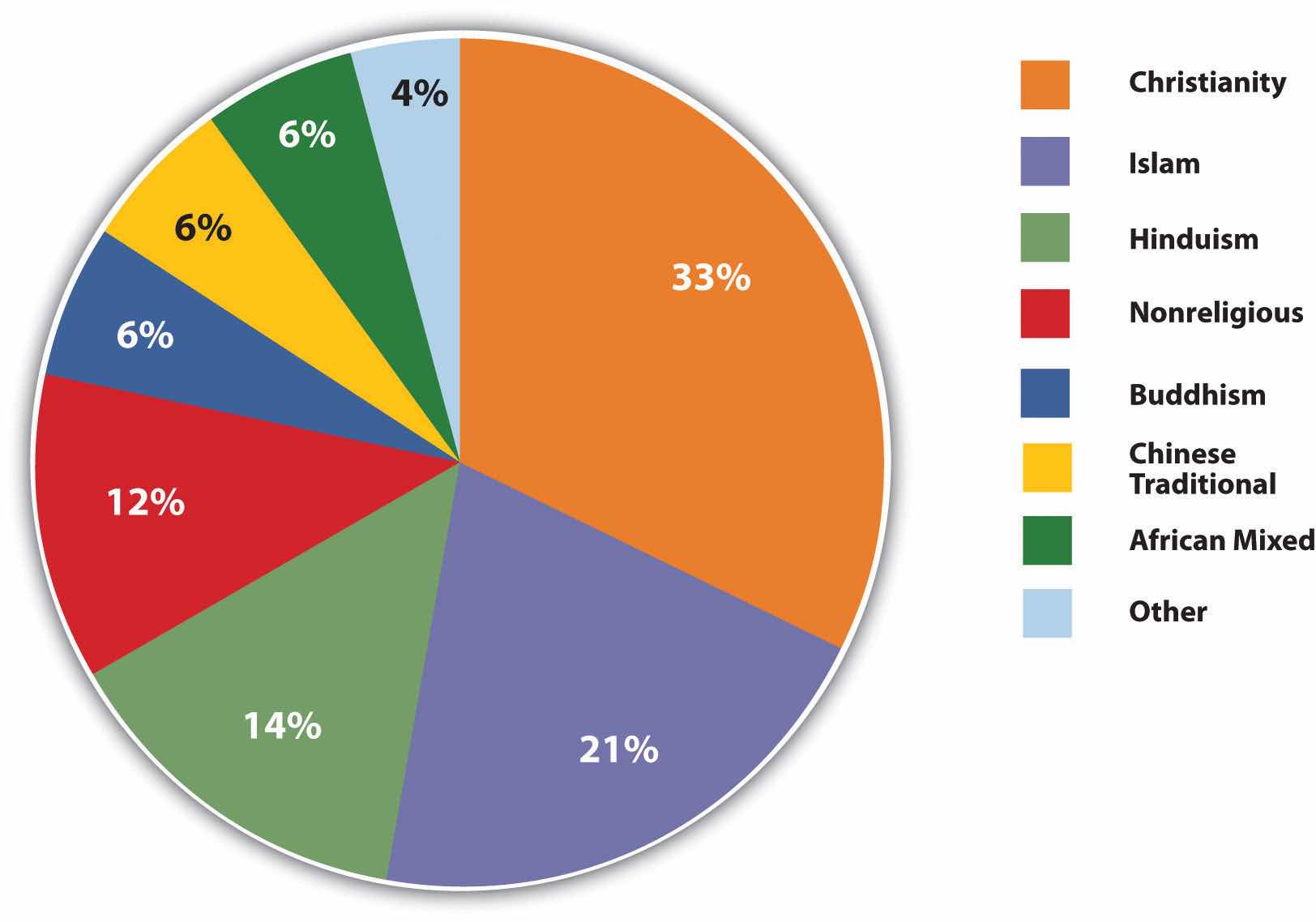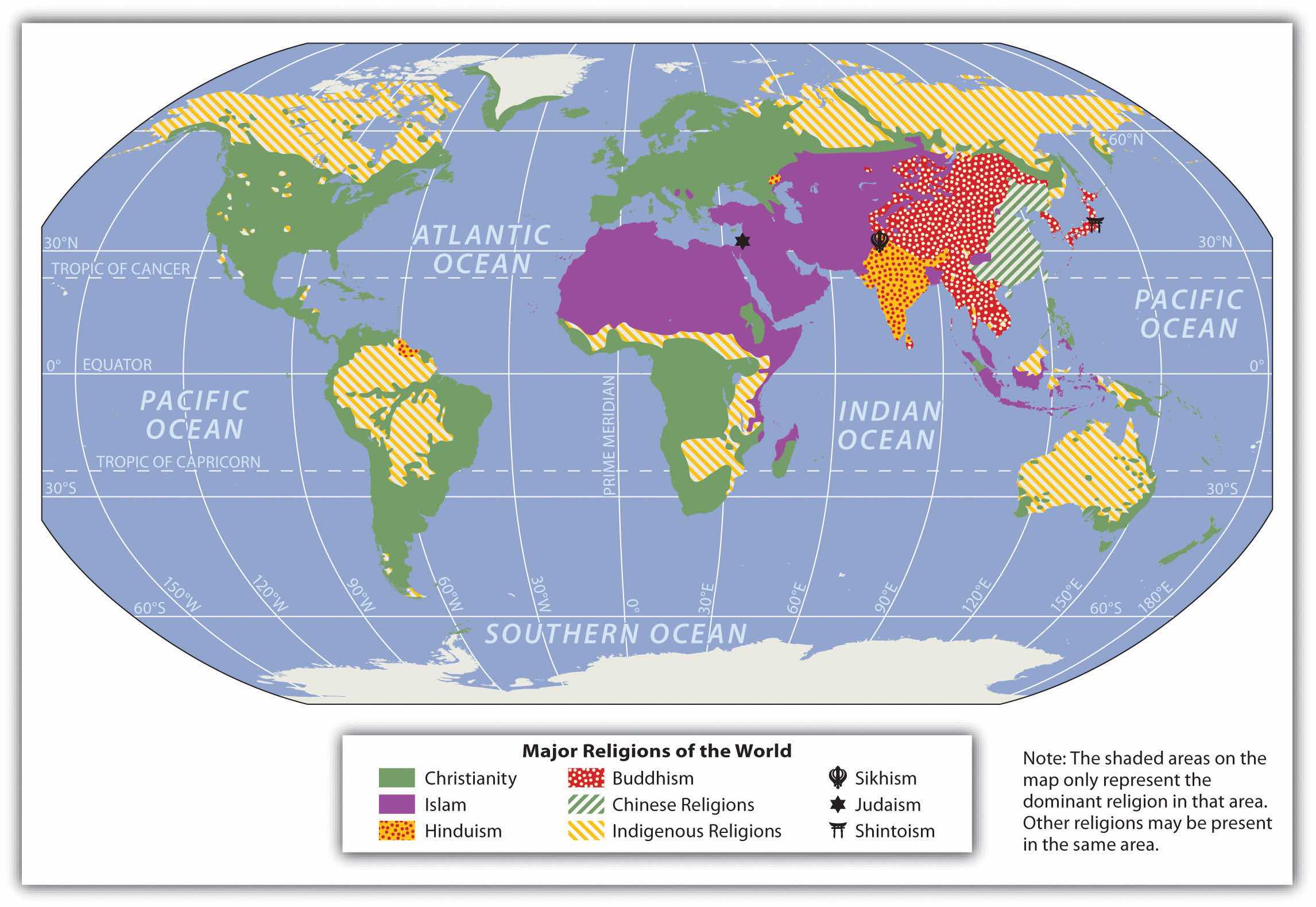DemographyThe study of how human populations change over time and space. is the study of how human populations change over time and space. It is a branch of human geography related to population geographyThe examination of the spatial distribution of human populations., which is the examination of the spatial distribution of human populations. Geographers study how populations grow and migrate, how people are distributed around the world, and how these distributions change over time.
For most of human history, relatively few people lived on Earth, and world population grew slowly. Only about five hundred million people lived on the entire planet in 1650 (that’s less than half India’s population in 2000). Things changed dramatically during Europe’s Industrial Revolution in the late 1700s and into the 1800s, when declining death rates due to improved nutrition and sanitation allowed more people to survive to adulthood and reproduce. The population of Europe grew rapidly. However, by the middle of the twentieth century, birth rates in developed countries declined, as children had become an economic liability rather than an economic asset to families. Fewer families worked in agriculture, more families lived in urban areas, and women delayed the age of marriage to pursue education, resulting in a decline in family size and a slowing of population growth. In some countries (e.g., Russia and Japan), population is actually in decline, and the average age in developed countries has been rising for decades. The process just described is called the demographic transition.
At the beginning of the twentieth century, the world’s population was about 1.6 billion. One hundred years later, there were roughly six billion people in the world, and as of 2011, the number was approaching seven billion. This rapid growth occurred as the demographic transition spread from developed countries to the rest of the world. During the twentieth century, death rates due to disease and malnutrition decreased in nearly every corner of the globe. In developing countries with agricultural societies, however, birth rates remained high. Low death rates and high birth rates resulted in rapid population growth. Meanwhile, birth rates—and family size—have also been declining in most developing countries as people leave agricultural professions and move to urban areas. This means that population growth rates—while still higher in the developing world than in the developed world—are declining. Although the exact figures are unknown, demographers expect the world’s population to stabilize by 2100 and then decline somewhat.
In 2010, the world’s population was growing by about eighty million per year, a growth rate found almost exclusively in developing countries, as populations are stable or in decline in places such as Europe and North America. World population increase is pronounced on the continent of Asia: China and India are the most populous countries in the world, each with more than a billion people, and Pakistan is an emerging population giant with a high rate of population growth. The continent of Africa has the highest fertility rates in the world, with countries such as Nigeria—Africa’s most populous and the world’s eighth most populous country—growing rapidly each year. The most striking paradox within population studies is that while there has been marked decline in fertility (a declining family size) in developing countries, the world’s population will grow substantially by 2030 because of the compounding effect of the large number of people already in the world—that is, even though population growth rates are in decline in many countries, the population is still growing. A small growth rate on a large base population still results in the birth of many millions of people.
Earth’s human population is growing at the rate of about 1.4 percent per year. If the current growth rate continues, the human population will double in about fifty years to more than twelve billion. The current population increase remains at about eighty million per year. A change in the growth rate will change the doubling time. Between 2010 and 2050, world population growth will be generated exclusively in developing countries.
The three largest population clusters in the world are the regions of eastern China, south Asia, and Europe. Southeast Asia also has large population clusters. Additional large population centers exist in various countries with high urbanization. An example is the urbanized region between Boston and Washington, DC, which includes New York City, Philadelphia, Baltimore, and neighboring metropolitan areas, resulting in a region often called a megalopolis. The coastal country of Nigeria in West Africa or the island of Java in Indonesia are good examples of large population clusters centered in the tropics.
Social dynamics and geography will determine where the new additions to the human family will live. Providing food, energy, and materials for these additional humans will tax many countries of the world, and poverty, malnutrition, and disease are expected to increase in regions with poor sanitation, limited clean water, and lack of economic resources. In 2010, more than two billion people (one-third of the planet’s population) lived in abject poverty and earned less than the equivalent of two US dollars per day. The carrying capacity of the planet is not and cannot be known. How many humans can the earth sustain in an indefinite manner? There is the possibility that we have already reached the threshold of its carrying capacity.
Figure 1.22 Population Growth from Year 1 to Year 2010 AD

Human population will continue to grow until it either crashes due to the depletion of resources or stabilizes at a sustainable carrying capacity. Population growth exacts a toll on the earth as more people use more environmental resources. The areas most immediately affected by increased populations include forests (a fuel resource and a source of building material), fresh water supplies, and agricultural soils. These systems get overtaxed, and their depletion has serious consequences. Type C climates, which are moderate and temperate, are usually the most productive and are already vulnerable to serious deforestation, water pollution, and soil erosion. Maintaining adequate food supplies will be critical to supporting a sustainable carrying capacity. The ability to transport food supplies quickly and safely is a major component of the ability to manage the conservation of resources. Deforestation by humans using wood for cooking fuel is already a serious concern in the arid and dry type B climates.
Figure 1.23

The three main human population clusters on the planet are eastern Asia, southern Asia, and Europe. Most of these regions with high population densities are in type C climates.
Source: Image courtesy of Cocoliras, http://commons.wikimedia.org/wiki/File:2006megacities-1-.jpg.
As countries move from an agricultural to an industrial economy, there is a major shift in population from rural to urban settings. The Industrial Revolution of the nineteenth century ushered in major technological developments and changes in labor practices, which encouraged migration from the farm to the city. Because of increased mechanization, fewer farm workers are needed to produce larger agricultural yields. At the same time, factories in urban areas have a great need for industrial workers. This shift continued into the information age of the late twentieth century and continues in many parts of the developing world in the current century.
A basic principle of population growth that addresses this rural-to-urban shift states that as countries industrialize and urbanize, family size typically decreases and incomes traditionally increase. Though this may not be true in all cases, it is a general principle that is consistent across cultural lines. Agricultural regions generally have a larger average family size than that of their city counterparts. Fertility rateThe number of children born to a woman in her lifetime whether they reach adulthood or not. is the average number of children a woman in a particular country has in her lifetime, whether or not they all live to adulthood. If a fertility rate for a given country is less than 2.1—the replacement level—the population of that country is in decline, unless there is significant immigration. A fertility rate greater than 2.1 indicates that the country’s population is increasing. Some children will never reach reproductive age nor have children of their own, so the replacement rate has to be slightly greater than 2. The concept of fertility rate is slightly different from the term family sizeThe number of children raised in a household., which indicates the number of living children raised by a parent or parents in the same household. In this textbook, family size is used to illustrate the concept of population growth and decline.
A country’s demographic statistics can be illustrated graphically by a population pyramid. A population pyramid is essentially two bar graphs that depict male and female age cohorts either in absolute size or as a percentage of the total population. Male cohorts are typically shown on the left side of the pyramid, and females are on the right side.
The shape of a country’s population pyramid tells a story about the history of its population growth. For example, a high-growth-rate country has a pyramid that is narrow at the top and wide at the bottom, showing that every year more children have been born than the year before. As family size decreases and women in a society have fewer children, the shape of the pyramid changes. A population pyramid for a postindustrialized country that has negative growth would be narrower at the bottom than in the middle, indicating that there are fewer children than middle-aged people. Four basic shapes indicate the general trends in population growth:
These shapes also illustrate the percentage of a population under the age of fifteen or over the age of sixty-five, which are standard indicators of population growth. Many postindustrial countries have a negative population growth rate. Their population pyramidsGraphic illustration of age cohorts by sex for a given population. are narrow at the bottom, indicating an urbanized population with small family sizes.
Figure 1.25 Population Pyramids

Angola had a fertility rate of 5.6 in 2011. Japan had a fertility rate of 1.4 in 2011.
Source: Data courtesy of US Census Bureau International Programs.
The term cultureAspects of life or societal norms that people learn after they are born. is often difficult to differentiate from the term ethnicityThe traits, attributes, or national identity that people are born with.. In this textbook, ethnicity indicates traits people are born with, including genetic backgrounds, physical features, or birthplaces. People have little choice in matters of ethnicity. The term culture indicates what people learn after they are born, including language, religion, and customs or traditions. Individuals can change matters of culture by individual choice after they are born. These two terms help us identify human patterns and understand a country’s driving forces.
The terms culture and ethnicity might also be confused in the issue of ethnic cleansingThe forced removal of one people (usually an ethnic group) from an area by another by military force or war., which refers to the forced removal of a people from their homeland by a stronger force of a different people. Ethnic cleansing might truly indicate two distinct ethnic groups: one driving the other out of their homeland and taking it over. On the other hand, ethnic cleansing might also be technically cultural cleansing if both the aggressor and the group driven out are of the same ethnic stock but hold different cultural values, such as religion or language. The term ethnic cleansing has been used to describe either case.
Figure 1.26 Major Language Families of the World

Language is the communication mode of human culture, and it represents the complete diversity of thought, literature, and the arts. All the billions of people on the planet speak at least one language. While Ethnologue, a publication pertaining to the world’s languages, estimates that there were 6,909 living languages in the world as of 2009, the exact number may never be determined. Other data sets count languages differently, but most agree that there are more than 6,000. There are even communities in various parts of the world where people can communicate by whistling messages to each other or by using clicking sounds.
Of the more than 6,000 languages, about a dozen are spoken by more than one hundred million people each. These are the world’s main languages used in the most populous countries. However, the vast majority of the world’s languages are spoken by a relatively small number of people. In fact, many languages have no written form and are spoken by declining numbers of people. Language experts estimate that up to half the world’s living languages could be lost by the end of the twenty-first century as a result of globalization. New languages form when populations live in isolation, and in the current era, as the world’s populations are increasingly interacting with each other, languages are being abandoned and their speakers are switching to more useful tongues.
There are nine dominant language families in the world. Each of the languages within a language family shares a common ancestral language. An example of a language family is the Indo-European family, which has a number of branches of language groups that come from the same base: a language called Proto-Indo-European that was probably spoken about six thousand years ago. As populations migrated away from the ancestral homeland, their language evolved and separated into many new languages. The three largest language groups of the Indo-European family used in Europe are the Germanic, Romance, and Slavic groups. Other Indo-European languages include Hindi (spoken in India) and Persian (spoken in Iran).
Table 1.2 Languages of the Continents
| World Area | Number of Languages | Percentage of All Languages |
|---|---|---|
| Africa | 2,110 | 30.5 |
| Americas | 993 | 14.4 |
| Asia | 2,322 | 33.6 |
| Europe | 234 | 3.4 |
| Pacific | 1,250 | 18.1 |
| Totals | 6,909 | 100.0 |
Source: M. Paul Lewis, ed., Ethnologue: Languages of the World, 16th ed. (Dallas: SIL International, 2009), accessed September 13, 2011, http://www.ethnologue.com.
Table 1.3 Thirteen Major Languages of the World
| Language | First Language (Millions of Speakers) | Second Language (Millions of Speakers) | Total Speakers (Millions) |
|---|---|---|---|
| Mandarin | 845 | 180 | 1,025 |
| Hindi/Urdu | 242 | 224 | 466 |
| Arabic (All) | 206 | 246 | 452 |
| English | 340 | 110 | 450 |
| Spanish | 329 | 53 | 382 |
| Russian | 144 | 106 | 250 |
| Bengali | 181 | 69 | 250 |
| Portuguese | 178 | 42 | 220 |
| Indonesian | 23 | 140 | 163 |
| German | 95 | 28 | 123 |
| Japanese | 122 | 1 | 123 |
| French | 65 | 55 | 120 |
| Punjabi | 109 | 6 | 115 |
| Languages with more than one hundred million speakers (speakers given in millions) | |||
| These thirteen languages are spoken by more than four billion people, or about 60 percent of the current world population in 2009. | |||
Source: M. Paul Lewis, ed., Ethnologue: Languages of the World, 16th ed. (Dallas: SIL International, 2009), accessed September 13, 2011, http://www.ethnologue.com.
Table 1.4 Nine Major Language Families
| 1. Indo-European languages |
| 2. Sino-Tibetan languages |
| 3. Niger-Congo languages |
| 4. Afro-Asiatic languages |
| 5. Austronesian languages |
| 6. Dravidian languages |
| 7. Altaic languages |
| 8. Austro-Asiatic languages |
| 9. Japonic languages |
| Note: There are more than nine language families, but these are the dominant ones with over one hundred million speakers each. |
|---|
Source: M. Paul Lewis, ed., Ethnologue: Languages of the World, 16th ed. (Dallas: SIL International, 2009), accessed September 13, 2011, http://www.ethnologue.com.
The following terms are used to describe language characteristics.
Religious geography is the study of the distribution of religions and their relationship to their place of origin. Religious geographers recognize three main types of religions: universal (or universalizing), ethnic (or cultural), and tribal (or traditional) religions. Universal religions include Christianity, Islam, and various forms of Buddhism. These religions attempt to gain worldwide acceptance and appeal to all types of people, and they actively look for new members, or converts. Ethnic religions appeal to a single ethnic group or culture. These religions do not actively seek out converts. Broader ethnic religions include Judaism, Shintoism, Hinduism, and Chinese religions that embrace Confucianism and Taoism. Finally, traditional religions involve the belief in some form of supernatural power that people can appeal to for help, including ancestor worship and the belief in spirits that live in various aspects of nature, such as trees, mountaintops, and streams (this is often called animism). Subsaharan Africa is home to many traditional religions.
Figure 1.27 Major Religions of the World and Their Respective Percentage of the World Population

Although the world’s primary religions are listed here, many other religions are practiced around the world, as well as many variations of the religions outlined here. The top four religions by population are Christianity, Islam, Hinduism, and Buddhism. Because the official doctrine of Communism was nonreligious or atheist, there are actually many more followers of Buddhism in China than demographic listings indicate. The percentage of the world’s population that follows Buddhism is probably much higher than the 6 percent often listed for this religion.
Figure 1.28 Major Religions of the World

Source: Image courtesy of J Intela, http://commons.wikimedia.org/wiki/File:Prevailing_world_religions_map.png.